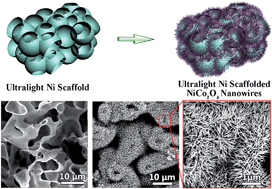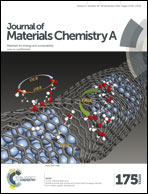Structure design of NiCo2O4 electrodes for high performance pseudocapacitors and lithium-ion batteries†
Abstract
High capacitance/capacity electrodes are in urgent demand to increase the charge storage capability of energy storage devices. However, there are some scientific and technical challenges for a large amount of charges to be transported through the devices because the kinetic resistances and volume change issues may limit the performance of devices. 3D conductive scaffolds are usually developed to build rapid electron/ion pathways and accommodate volume changes. Using a templated electrodeposition and hydrothermal synthesis technique, we developed a composite electrode consisting of NiCo2O4 nanowires on ultralight nickel foam. The NiCo2O4 nanowires provide a large surface for rapid charge transports. The ultralight nickel foam electrically wires NiCo2O4 and accommodates the volume expansion of NiCo2O4 during lithiation. The composite electrode demonstrates a high performance microstructure for ideal pseudocapacitors and lithium ion anodes. It not only enhances the utilization of active materials but also increases the electrode based specific capacitance by one order of magnitude as compared to the widely used nickel foam. More importantly, the ultralight nickel foam supported structure could further be extended to other high capacitance/capacity metal oxide materials for pseudocapacitors and lithium-ion battery applications.


 Please wait while we load your content...
Please wait while we load your content...